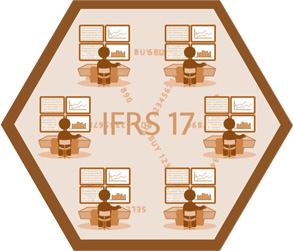IFRS 17 Insurance Contracts was issued by the International Accounting Standards Board (Board) in 2017 and comes into effect in 2021. Financial journalist Liz Fisher takes a look at what the new Standard means for the investor community.
The insurance sector has long been a special case when it comes to financial reporting. The complexity of insurance, its long-term nature and the inherent difficulty in identifying 'revenue' as any other business would understand it has set it apart—with the result that an insurance company's financial statements look and feel unlike any other. But that will change in 2021 with the implementation of the Board's new global Standard, IFRS 17 Insurance Contracts.
The new Standard represents a seismic change not only for the insurance companies that will use it but for the user community, and particularly for analysts covering the sector across the world. Some compare the scale of the change to the 2005 adoption of IFRS Standards in Europe; insurers' financial statements and key performance indicators will be radically transformed. 'I've been covering the insurance sector for almost 20 years and it's by far the biggest change I have seen,' says Doug Young of Desjardins Capital Markets in Canada.
While many are expecting a turbulent bedding-in period when the Standard first comes into effect, insurance analysts across the world believe it will make a huge difference to the consistency and comparability of insurance companies.
The trouble with IFRS 4, the interim insurance contracts Standard
The Board began its project to develop a consistent global approach to insurance accounting in 1997, and in 2004 issued its interim insurance Standard, IFRS 4, to address urgent issues in the run-up to adoption of IFRS Standards by listed companies in Europe and beyond. While IFRS 4 introduced vital improvements to recognition and measurement of insurance contracts and to disclosure requirements, the fact that it allows insurers to use local GAAP (Generally Accepted Accounting Principles) means that identical insurance contracts can be accounted for differently by different insurers. As a result, insurers' financial statements are almost impossible to compare against each other.
The opacity of insurance-company financial statements means that analysts have to take an entirely different approach to the sector. Roger Doig, European equities analyst at Schroders, says he has not used an insurer's IFRS balance sheet as a basis for valuation 'for 15 years or more' as it does not provide any of the information he needs. 'What interests me is a company's ability to pay dividends, and that is built around understanding the regulatory view of the balance sheet. The balance sheet under IFRS 4 is totally irrelevant.' Instead, he says, the main relevant metrics for assessing whether a dividend can be paid is Solvency II capital adequacy information. 'The problem is that Solvency II doesn't give you an operating performance measure, so we have to fall back on the IFRS P&L account.'
And this is where the real problems begin—in assessing earnings and performance under IFRS 4. Séverine Piquet, senior investment analyst at BNP Paribas Asset Management, describes insurer financial statements as 'a black box'. 'Profits are not recorded in the same way by different insurers—some are recorded faster or slower than others,' she says. 'And we have no idea which year has generated the most profits.'
 'It's
very difficult for us to see the performance of an insurance business and
insurers can pretty much produce any figures they want,' adds Patricia Cheng,
Head of China Financial Research at CLSA in Hong Kong. 'It's very frustrating to
me as an analyst.
'It's
very difficult for us to see the performance of an insurance business and
insurers can pretty much produce any figures they want,' adds Patricia Cheng,
Head of China Financial Research at CLSA in Hong Kong. 'It's very frustrating to
me as an analyst.
'The normal ratios just don't apply and a lot of information depends very much on assumptions—if a company is showing a growth rate of 20%, for example, you might find that a lot of that is down to a change in assumptions. So, at the moment, we take a "story-telling" approach to investment trends. If the financial performance figures show growth, and it seems to gel with the story, people will accept that.'
Both insurers and analysts have come up with their own ways to explain performance, but while this might help some investors, it adds to the overall lack of comparability. Doug Young of Desjardins explains that analysts in Canada construct a 'sources of earnings' statement in order to give investors an idea of how reserves are rolling off. 'There is also an "expected profit" line in Canada, which shows the unwinding of insurance liabilities, but some companies include things like acquisition costs, that others don't,' he says.
'It is possible to make sensible projections for non-life business based on the information you get,' says Schroders' Doig. 'The real problem is with life companies because you get deposit lumped in with premiums and large moving parts going in and out of reserves, and these are impossible to predict.' Many large insurers provide information on the drivers of insurance performance to help users better understand. 'We use these additional disclosures to project operating earnings of life companies, which we add to the IFRS 4 figures for non-life and asset management business so we can make estimates of what we think the underlying growth in earnings for an insurance group will be.'
The problem is that not all companies produce this information and there is little consistency from insurer to insurer among those that do. 'Smaller companies don't provide this supplementary information at all,' says Doig, 'and among the others, some provide it geographically, and some on a product-by-product basis.'
This means, essentially, that insurers set the parameters for communicating their performance to the market. 'What I have to do at the moment is explain what is happening on a company-by-company basis, and that is not the case for any other industry. Insurance is completely unique in that,' says Piquet.
Comparability and transparency
All agree that IFRS 17 will greatly improve comparability between insurers, as well as increase the transparency around the drivers of performance and source of earnings. The recognition of profits as insurance services are provided and comprehensive disclosures about judgments made and changes in assumptions, are particularly welcome.
'IFRS 17 will bring more transparency and make it easier to compare insurance companies,' says Patricia Cheng. 'It will help us better understand the drivers of the business. But no financial statements can truly reflect the profitability of an insurance company—there is no standard that can do that. But what IFRS 17 will do is bring us back to the financial statements, rather than the story.'
 It is hoped that the Standard will also help
to clarify the picture around risk in the insurance sector. The International
Monetary Fund's October
2017 Global Financial Stability Report called on policymakers to
strengthen regulation and disclosure in the sector to make sure that insurers
were not taking excessive risks: 'Risk assessment in the insurance sector
suffers from opaque and heterogeneous financial disclosure and deficiencies in
the accounting and regulatory regimes,' it said.
It is hoped that the Standard will also help
to clarify the picture around risk in the insurance sector. The International
Monetary Fund's October
2017 Global Financial Stability Report called on policymakers to
strengthen regulation and disclosure in the sector to make sure that insurers
were not taking excessive risks: 'Risk assessment in the insurance sector
suffers from opaque and heterogeneous financial disclosure and deficiencies in
the accounting and regulatory regimes,' it said.
The Standard's requirements are now set but some analysts are struggling to understand what the consequences will be for individual companies on transition. 'We aren't able to do any modelling about what results and financial performance might look like under IFRS 17 because we don't have access to the cash flow information we need,' says Cheng. 'It would be useful to have quantitative impact studies from insurers,' adds Piquet. 'I hope we will get them.'
Impact around the world
The impact of IFRS 17 is expected to be greater in some regions—such as those that routinely use historical interest rate information—than in others. In Asia and Europe, for example, embedded value reporting is voluntarily offered by many insurers to provide information on long-term contracts. While the information about the profitability of long-term contracts provided under IFRS 17 will be more comparable than embedded value reporting, moving away from embedded value will be a significant change for investors. 'IFRS 17 could make embedded value irrelevant, and that is a huge change in mindset and methodology,' says Cheng. 'The overall impact will depend on what insurers' results look like under IFRS 17, and we just don't know what that will be. We're walking into the unknown, but at least everyone is doing it together.'
Some analysts are concerned about transitional arrangements to the new Standard. 'The accounts will be very difficult to read at the beginning, and we will be losing a history of data,' says Piquet. She is also concerned that the format of key statements could differ from company to company: 'It would be helpful if there was a standard P&L model available for everyone to follow, so no-one tries to reinvent the wheel—without a standard approach we could lose some of the visibility that will be gained.'
Others are more confident. 'People adjusted relatively quickly to IFRS 4,' says Doig. 'I'm not sure transition is going to be as disruptive as some suggest it could be.'
'We know that implementing the new Standard is a very big task for insurance companies,' says Hans Hoogervorst, Chair of the International Accounting Standards Board. 'So in addition to preparing the investors for IFRS 17 through education events, we are delivering a lot of supporting materials to help people understand the Standard.' The Board has also set up a Transition Resource Group to create a public discussion forum where implementation challenges can be debated by experts who will be directly involved with implementing the Standard.
Perhaps the most critical question is whether IFRS 17 and the transparency and comparability it promises to bring will make the insurance sector a more attractive prospect for investors. BlackRock has said that the Standard 'has the potential to provide more accurate and comparable insights into insurers' balance sheets and profitability, thereby improving investor understanding of the sector', and most analysts agree that the opacity of insurance accounting has contributed to the perception that the sector is only for the brave.
'Portfolio managers are put off by insurance and insurance accounting,' says Doig. 'Once people get used to the new Standard, earnings forecasts will be easier to come by and the drivers will be easier to understand. We will have granularity in terms of the drivers of earnings, most importantly by product or group. Some insurers do already provide that information but it will be very useful to have it for everyone, particularly smaller insurers. Will that make investors more confident in the sector? I think it might.'